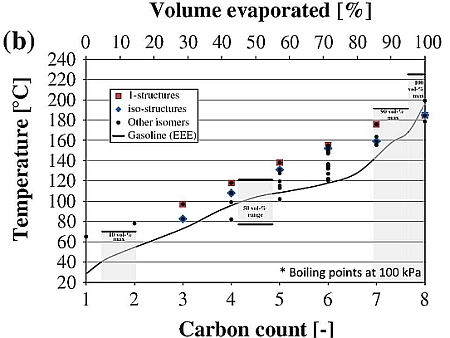Best that I've been able to find so far is that HTHS gets affected at about half the percentage loss of KV100, regardless of the mechanism (typically). And fuel dilution typically helps things like MRV and CCS while it is there as fuel.
I tried ages ago to try to model at least the KV100 changes with fuel dilution% as a "mix", and it's really not doable/that simple, as different oils and chemistries respond differently...e.g. VII molecules are more "active" in thinner basestocks than thicker, as they are sheared less in action.
Other characteristics of particular oils make the results non predictable also. (This paper is for diesel, and biofuels and blends, but what happens with one oil can be completely different to another.
http://www.transport-research.info/sites...vity_Report.pdf
As to "burning off" fuel with highway operation, here's a distillation curve of some gasoline and alcohol components. So clearly, SOME of the fuel has to stay, regardless of sump temperatures.

Best defence is Miyagi's "best defence is no be there"
Another brief paper FYI
http://hrcak.srce.hr/file/75680
I tried ages ago to try to model at least the KV100 changes with fuel dilution% as a "mix", and it's really not doable/that simple, as different oils and chemistries respond differently...e.g. VII molecules are more "active" in thinner basestocks than thicker, as they are sheared less in action.
Other characteristics of particular oils make the results non predictable also. (This paper is for diesel, and biofuels and blends, but what happens with one oil can be completely different to another.
http://www.transport-research.info/sites...vity_Report.pdf
As to "burning off" fuel with highway operation, here's a distillation curve of some gasoline and alcohol components. So clearly, SOME of the fuel has to stay, regardless of sump temperatures.

Best defence is Miyagi's "best defence is no be there"
Another brief paper FYI
http://hrcak.srce.hr/file/75680


